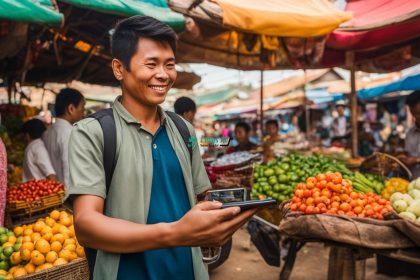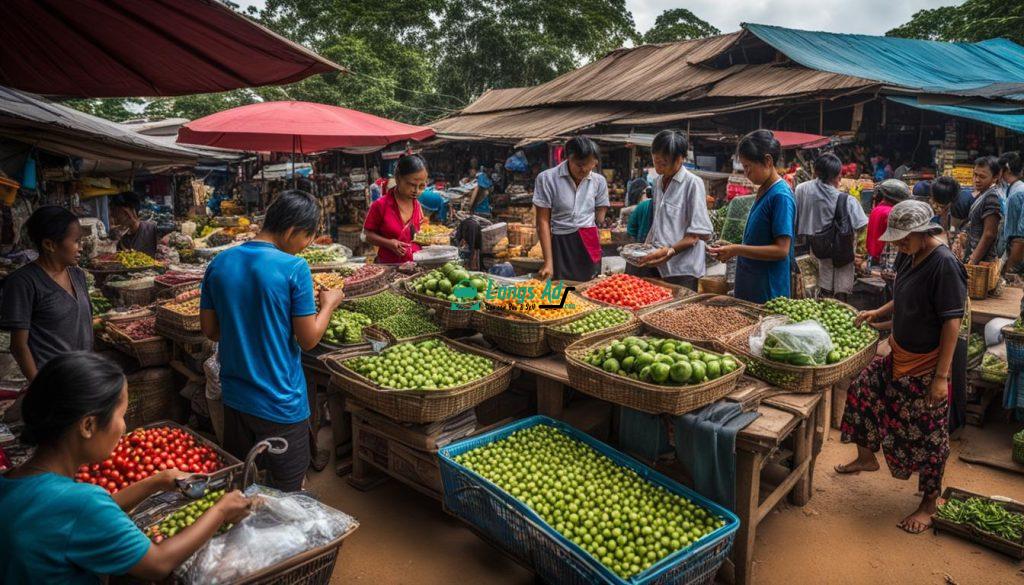
Welcome to the thriving e-commerce landscape of Cambodia! With strong government support, a growing urban population, high internet penetration, and increasing social media adoption rates, Cambodia’s online marketplace is set to become one of the fastest-growing markets in the region. Whether you’re looking to buy or sell products, Cambodia’s e-commerce platform offers convenience, variety, and endless possibilities.
From fashion and apparel to food and groceries, Cambodia’s online marketplace caters to a wide range of consumer needs. With the popularity of cashless payments soaring, online shopping has become the preferred choice for the majority of Cambodians. Say goodbye to the hassle of carrying cash and hello to the seamless experience of shopping from the comfort of your home.
But it doesn’t stop there. Cambodia’s e-commerce ecosystem is evolving rapidly, with a focus on developing a well-integrated e-logistics system to ensure smooth product delivery. As more industries recognize the potential of online selling, opportunities for growth in sectors like fashion, food and grocery delivery, insurance, and online education are on the rise.
Key Takeaways:
- Cambodia’s e-commerce sector is expected to be one of the region’s fastest-growing markets.
- Cashless payments have gained popularity, with 68% of Cambodians using online payment methods for shopping.
- Fashion and apparel are among the most purchased items online in Cambodia.
- The potential for growth exists in various industries, including food and grocery delivery, insurance, and online education.
- Challenges such as limited broadband access and a lack of trust in online transactions need to be addressed.
The Growing Trend of Cashless Payments and Online Shopping in Cambodia
The e-commerce landscape in Cambodia has witnessed a significant shift towards cashless payments and online shopping. As the world continues to navigate the challenges of the Covid-19 pandemic, Cambodians have embraced the convenience and safety of digital transactions, resulting in a surge in cashless payments. In fact, adoption rates have increased from 40% in 2020 to an impressive 68% in 2021 (source: E-commerce in Cambodia Report).
The rise of online shopping has been a key factor driving the growth of cashless payments in Cambodia. With the convenience of browsing through a wide range of products and the ability to compare prices, Cambodians are flocking to online marketplaces and classifieds to fulfill their shopping needs. Platforms such as Tinh Tinh E-Commerce, AliExpress, and Facebook have emerged as popular avenues for buying and selling goods in the country (source: E-commerce in Cambodia Report).
“The gap between online and cash payment preferences has significantly reduced, with convenience being the biggest factor influencing a preference for digital payments.”
One of the driving factors behind this shift is the increasing confidence in digital payment methods. Cambodians now recognize the convenience and security of cashless transactions, reducing the gap between online and cash payment preferences. With improved access to reliable internet services and the availability of e-commerce platforms, online shopping has become the preferred method for many Cambodians to make purchases (source: E-commerce in Cambodia Report).
In conclusion, Cambodia is experiencing a growing trend of cashless payments and online shopping. With the convenience and safety they offer, digital transactions have become increasingly popular among Cambodians. As the e-commerce sector continues to evolve and grow in the country, it is expected that cashless payments and online shopping will become even more prevalent. Embrace the future of e-commerce in Cambodia and enjoy the ease of buying and selling online today!
The Potential of E-commerce in Various Industries in Cambodia
The E-commerce in Cambodia report highlights the potential for growth in various industries. Here’s a breakdown of the key sectors:
Fashion Industry
The fashion industry in Cambodia has been experiencing rapid growth since 2019. This can be attributed to urbanization, a growing high-income consumer base, and the emergence of a middle class. Online fashion retailers have been capitalizing on this trend by offering a wide range of clothing, accessories, and beauty products through online platforms. The convenience of online shopping, combined with the ability to access a greater variety of products, has made it an attractive option for fashion enthusiasts in Cambodia.
Food and Grocery Delivery
The online food and grocery delivery sector in Cambodia has seen significant growth in the past few years. However, due to eased restrictions on dining out, the growth rate has slowed down in 2021 and 2022. Nevertheless, there is still potential for further expansion in this sector, particularly as more consumers continue to adopt online shopping habits. With an increasing number of food and grocery delivery platforms available, Cambodians now have the convenience of having their favorite meals and daily necessities delivered right to their doorstep.
Insurance
While insurance products are generally less likely to be purchased online, there has been a rise in demand for life and health insurance in Cambodia, especially in light of the ongoing pandemic. The convenience and accessibility of online insurance platforms have made it easier for individuals to compare and choose the coverage that suits their needs. As more Cambodians recognize the importance of having insurance protection, the online insurance sector is expected to grow further in the coming years.
Online Education
The online education sector has experienced significant growth in Cambodia, particularly during the pandemic when traditional classroom learning was disrupted. The shift to online learning has opened up opportunities for online education businesses to thrive. With the availability of e-learning platforms and digital resources, Cambodian students and professionals can now access quality education and professional development courses from the comfort of their homes. This sector is likely to continue growing as more people recognize the benefits and flexibility of online learning.
| Industry | Key Factors |
|---|---|
| Fashion | Urbanization, growing high-income consumer base, emergence of a middle class |
| Food and Grocery Delivery | Convenience, ease of access to a variety of products |
| Insurance | Rise in demand for life and health insurance, convenience of online platforms |
| Online Education | Shift to online learning, accessibility of e-learning platforms |
These industries represent just a snapshot of the potential for e-commerce growth in Cambodia. With the right infrastructure, government support, and consumer adoption, the e-commerce market in Cambodia is poised for further expansion in the coming years. Entrepreneurs and businesses looking to tap into the Cambodian market should consider these key sectors and capitalize on the growing demand for online products and services.
Overcoming Challenges in E-commerce in Cambodia

While Cambodia’s e-commerce market has immense potential, there are several challenges that need to be addressed for its successful development. Limited broadband access and financial exclusion are barriers that hinder the growth of the e-commerce market. Many Cambodians still do not have access to stable and high-speed internet connections, which restricts their ability to participate in online shopping. Additionally, a significant portion of the population is financially excluded, lacking access to digital payment methods and bank accounts necessary for online transactions.
Mistrust in online transactions also poses a challenge to e-commerce in Cambodia. Many consumers are skeptical about the security and reliability of online platforms, which affects their willingness to make purchases online. Building trust in e-commerce platforms and ensuring secure online transactions are crucial to overcoming this challenge and encouraging more Cambodians to embrace online shopping.
The lack of harmonization of regulatory frameworks is another obstacle to the development of the e-commerce market in Cambodia. Clear and consistent regulations are essential to providing a stable and secure environment for e-commerce businesses to operate. Harmonizing existing regulations and implementing new ones that address the unique challenges of the digital economy will contribute to the growth and success of e-commerce in Cambodia.
| Challenges | Impact |
|---|---|
| Limited broadband access | Restricts the participation of many Cambodians in online shopping |
| Financial exclusion | Limits the ability of individuals to make online payments |
| Mistrust in online transactions | Affects consumer willingness to make purchases online |
| Lack of harmonization of regulatory frameworks | Creates a fragmented and uncertain environment for e-commerce businesses |
Addressing these challenges requires a multi-faceted approach involving various stakeholders. Efforts to improve broadband infrastructure and expand internet access should be prioritized, particularly in rural areas where connectivity is still limited. Promoting financial inclusion through initiatives that provide accessible digital payment solutions and financial literacy programs can help bridge the gap and enable more Cambodians to engage in e-commerce.
Furthermore, raising awareness about the security measures and consumer protections in place for online transactions is crucial in building trust among Cambodian consumers. Implementing and enforcing robust regulations that support the growth of e-commerce while safeguarding consumer interests will provide a solid foundation for the industry to thrive in Cambodia.
Cambodia has the potential to become a vibrant e-commerce market, but overcoming these challenges is essential for realizing this potential. By addressing the issues of limited broadband access, financial exclusion, mistrust in online transactions, and regulatory harmonization, Cambodia can create an enabling environment that fosters the growth of e-commerce and benefits both businesses and consumers.
The Growing E-commerce Landscapes: Cambodia, China, and South Korea
As e-commerce continues to flourish globally, it’s essential to understand the unique dynamics and trends in different markets. This section compares the e-commerce landscapes of Cambodia, China, and South Korea, highlighting their distinctive features and opportunities. By examining these contrasting markets, we can gain valuable insights and learn from successful strategies implemented in each country.
E-commerce in China: A Powerhouse of Online Marketplaces
China’s e-commerce market is undeniably one of the largest and most developed in the world. Dominated by major players like Alibaba, this market offers a wide range of products and services for consumers. Rural e-commerce, social commerce, and cross-border e-commerce are major trends in China, driving immense growth and innovation in the industry. With a massive online consumer base and a robust logistics infrastructure, the Chinese e-commerce market sets a benchmark for other countries to aspire to.
E-commerce in South Korea: M-Commerce and Market Maturity
South Korea’s e-commerce industry is characterized by its strong emphasis on mobile commerce (m-commerce). The country boasts one of the highest smartphone penetration rates globally, making it a thriving market for online shopping through mobile apps. Online groceries and increasing market maturity are other notable features of the South Korean e-commerce landscape. With a well-established infrastructure and high adoption of digital technologies, South Korea presents opportunities for both local and foreign businesses.
E-commerce in Cambodia: A Growing Market with Unique Selling Propositions
Compared to China and South Korea, Cambodia’s e-commerce market is still in its early stages of development. However, it offers unique opportunities for local players to tap into a niche market. One of Cambodia’s key selling propositions is the ability to provide products that are not readily available in regular retail outlets. As the online marketplace grows, Cambodian consumers gain access to a wider range of products and enjoy the convenience of online shopping. With the right infrastructure and regulatory support, Cambodia has the potential to become an important player in the regional e-commerce scene.
Comparison of Key Features
| China | South Korea | Cambodia | |
|---|---|---|---|
| Market Size | Largest e-commerce market globally | Maturing market with high potential | Growing market with immense potential |
| Mobile Commerce | Significant emphasis on m-commerce | Strong focus on m-commerce | Mobile adoption increasing, potential for growth |
| Social Commerce | Thriving social commerce scene | Growing influence of social commerce | Developing social commerce ecosystem |
| Market Dominance | Dominated by major players like Alibaba | Mixture of local and international players | Opportunities for local players to establish presence |
While each country has its unique characteristics, learning from the successes and challenges faced in these e-commerce markets is crucial for the sustainable growth of the industry in Cambodia. By analyzing the e-commerce landscapes of China and South Korea, Cambodia can adapt and implement strategies suitable for its own market, ensuring a thriving and competitive e-commerce ecosystem.
The Future of E-commerce in Cambodia

The e-commerce landscape in Cambodia is poised for a promising future. With the continued support of the government, a growing urban population, and increasing internet penetration, the market is set to experience further growth and development. Cambodia’s online marketplace offers a wide range of opportunities for businesses and consumers alike. Whether you are looking to buy or sell goods, the convenience and accessibility of Cambodian online shopping platforms make it easier than ever to connect with customers and find the products you need.
One of the key areas of growth in the future of e-commerce in Cambodia is the fashion industry. As urbanization continues and the middle class expands, there is a rising demand for fashion and apparel products. Online marketplaces provide a platform for local and international brands to showcase their products and reach a wider customer base. With the ease of online payments and delivery services, buying fashion items online has become a popular choice for Cambodian consumers.
The Potential of E-commerce in Cambodia
Aside from fashion, other industries also hold significant potential for growth in the e-commerce sector. The COVID-19 pandemic has highlighted the importance of online food and grocery delivery, and this trend is expected to continue. Insurance products, particularly life and health insurance, have seen increased demand in light of the global health crisis. The shift to online education during the pandemic has opened up opportunities for online learning platforms to thrive in Cambodia.
To fully realize the potential of e-commerce in Cambodia, there are challenges that need to be addressed. Limited broadband access, financial exclusion, and a lack of trust in online transactions are barriers that must be overcome. Additionally, the development of a well-integrated e-logistics system is crucial for a thriving e-commerce ecosystem. By improving infrastructure, strengthening regulatory frameworks, and building trust among consumers, Cambodia can create a favorable environment for the growth of e-commerce.
The Future of E-commerce in Cambodia
In conclusion, the future of e-commerce in Cambodia looks bright. With government support, a growing urban population, and increasing internet penetration, the market is poised for further growth in various industries. Fashion, food and grocery delivery, insurance, and online education are just some of the sectors that hold immense potential in the Cambodian e-commerce landscape. By addressing challenges and fostering a conducive environment for e-commerce development, Cambodia has the opportunity to become a thriving online marketplace in the region.
Conclusion
In conclusion, Cambodia’s e-commerce market is brimming with potential. With strong government support, high internet penetration rates, and a growing preference for online shopping, Cambodia is poised to become a thriving hub for online marketplaces and e-commerce platforms.
Although there are challenges to overcome, such as limited broadband access and concerns about trust in online transactions, the future looks bright for e-commerce in Cambodia. By focusing on improving infrastructure, implementing effective regulatory frameworks, and fostering greater awareness among consumers, Cambodia can create the perfect environment for a thriving e-commerce ecosystem.
So whether you’re a buyer or a seller, it’s time to seize the opportunity and dive into Cambodia’s online marketplace. Explore the wide range of products and services available, experience the convenience of shopping from the comfort of your own home, and be part of Cambodia’s e-commerce revolution. Start your e-commerce journey in Cambodia today!
FAQ
What factors are driving the growth of e-commerce in Cambodia?
The growth of e-commerce in Cambodia is being driven by strong government support, a growing urban population, high internet penetration, and increasing adoption rates of social media.
What are the most purchased items online in Cambodia?
The most purchased items online in Cambodia are fashion and apparel.
How popular are cashless payments in Cambodia?
Cashless payments have surged in popularity in Cambodia, with 68% of Cambodians using online payment methods for online shopping.
What are the popular platforms for buying and selling goods in Cambodia?
Popular platforms for buying and selling goods in Cambodia include Tinh Tinh E-Commerce, AliExpress, and Facebook.
Which industries have the potential for growth in the e-commerce sector in Cambodia?
Industries such as fashion, food and grocery delivery, insurance, and online education have the potential for growth in the e-commerce sector in Cambodia.
What are the challenges to the development of the e-commerce market in Cambodia?
Challenges to the development of the e-commerce market in Cambodia include limited broadband access, financial exclusion, mistrust in online transactions, and a lack of harmonization of regulatory frameworks.
How does Cambodia’s e-commerce market compare to China and South Korea?
Cambodia’s e-commerce market is still growing, with opportunities for local players to tap into unique selling propositions. China’s e-commerce market is well-developed and dominated by major players like Alibaba, while South Korea’s market is characterized by m-commerce and online groceries.
What is the future of e-commerce in Cambodia?
The future of e-commerce in Cambodia looks promising, with continued government support, a growing urban population, and increasing internet penetration.


